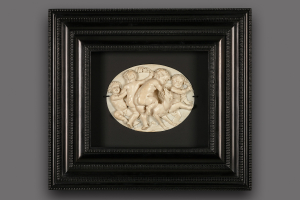French Gothic Left Panel from a diptych depicting The Glorification of the Virgin
French Gothic Left Panel from a diptych depicting The Glorification of the Virgin
This large leaf from the left side of a grand Gothic ivory diptych from Paris can be dated to the second quarter of the 14th century, when closely related diptychs in the Victoria and Albert Museum and The Courtauld Institute are also thought to have been carved. The leaf is decorated with one of the most iconic images of Gothic art, the Glorification of the Virgin, in which the Virgin Mary stands with the Infant Christ on her arms among adoring angels, usually bearing candles, swinging censers and carrying incense burners. Aside from the obvious charm of the characters the relief is distinguished by the depth of the carving as well as such details as the wonderfully elaborated tripod candlesticks and the manner in which they are held up to the Virgin.
Ivory diptychs, conveniently hinged to close flat, were produced in the 14th-century to satisfy the popular demand for luxurious but portable devotional imagery. Usually the scene of the Glorification of the Virgin, holding the Christ Child as she is censed by angels, is paired with the Cross with the Virgin and St. John sorrowful at its foot. In this manner the artist juxtaposed two great Christian mysteries: Christ's Birth and His Passion. This didactic strategy would not have been lost on the worshipper, who would have meditated on the relationship between the two scenes with the object in his or her hands. Even though the Glorification of the Virgin is a particularly recognisable medieval image, it seems to have been of particular currency in ivory sculpture. The composition probably derives from three free-standing figures in the Treasury of the Basilica of Saint-Denis, which were joined to form a triptych with the angels on the wings (see Lowden, op.cit., p. 70). By 1300 the scene, together with the closely related Crowning of the Virgin, is a recurrent component of many Parisian ivory reliefs. At that time the angels are more often represented with wings and the facial features tend to be more diminutive but the basic composition, especially that of the Child, is identical to the present ivory (see Williamson/ Davies, op. cit., nos. 73 and 74). While examples
dated to just before 1350 include a very similar architecture with three arches from which pointed spires emerge and the wingless angels, they have more animated figures, often with dense drapery schemes (see Lowden, op.cit. and Williamson/ Davies, op. cit., no. 86). The present relief can therefore possibly be dated a few years earlier than that group.
Published:
Gothic Ivories Project at The Courtauld Institute of Art, London, Wing, left (fragment of a diptych) 1 register, 3 arches across (plaquette; frise d'arcatures) (Front), available at: http://www.gothicivories.courtauld.ac.uk/images/ivory/5D272E64_1aa391b7.html
Literature:
T. Jülich, Die mittelalterlichen Elfenbeinarbeiten des Hessischen Landesmuseum Darmstadt, Regensburg, 2011, pp. 176-177, no. 35; J. Lowden, Medieval and later ivories in The Courtauld Gallery, London, 2013, pp. 68-71, no. 8;
P. Williamson and G. Davies, Medieval ivory carvings 1200-1550. Part I, cat. Victoria and Albert Museum, pp. 232-237 and 266-271, nos. 73-74 and 86-87.
Technical analysis:
Radiocarbon dating measurement report no. AA 13-18042, prepared by Antiques Analytics GmbH, Eppstein, dd. 2 July 2013, states that the ivory dates between 1065 and 1166 CE (67.7% confidence interval).
- Provenance
- Sotheby’s London, 15 May 1952, lot 149
Private collection, the Netherlands - Period
- ca. 1325-1350
- Material
- sculpted and polychromed ivory
- Dimensions
- 15.5 x 10.3 cm
Global shipping available









